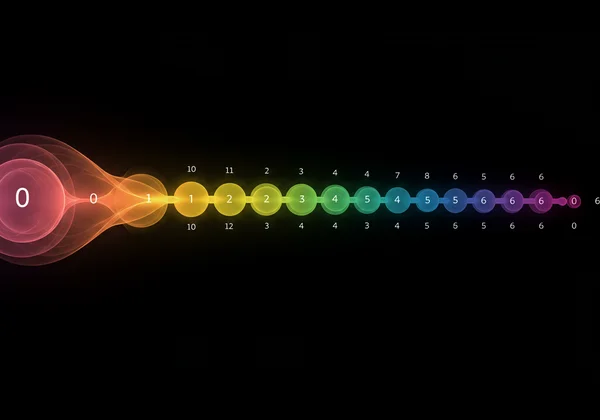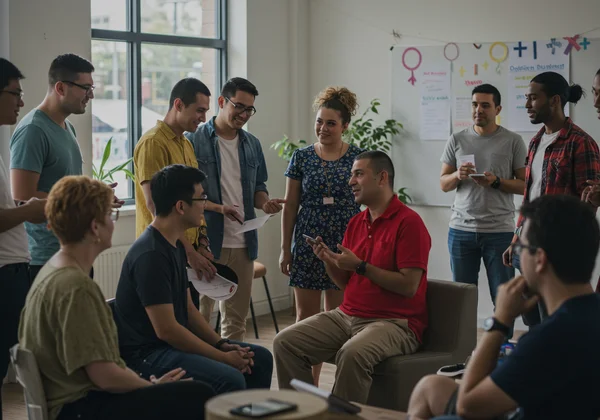Sharing Your Kinsey Scale Results: A Guide to Discussing It
Taking the Kinsey Scale test can be an illuminating moment on your journey of self-discovery. Holding your result, you might feel a wave of affirmation, a flicker of curiosity, or even a sense of uncertainty. It's a deeply personal insight, and a natural next question often follows: How do you share this personal insight with others? Whether you're considering talking to a close friend, a family member, or a partner, this guide is here to help you navigate that conversation with confidence and care. This is your story, and you get to decide how it's told. If you're just beginning this journey, you can always start your Kinsey Scale exploration on our homepage.

Preparing to Discuss Your Kinsey Scale Results
Before you open up to someone else, it's incredibly helpful to first ground yourself in your own experience. A bit of preparation can transform a potentially anxious conversation into an empowering one. This isn't about creating a perfect script; it's about building a foundation of self-assurance so you can speak from a place of clarity and strength.
Self-Reflection: Understanding Your Own Score Deeply
Your Kinsey Scale score is more than just a number; it’s a reflection of your unique experiences with attraction and behavior. Before sharing it, take a moment for some personal interpretation. Ask yourself what this result means to you. Does it confirm something you’ve always felt? Does it open up new questions? Remember, the scale represents a spectrum, a fluid continuum rather than a rigid box. Your feelings are the most important part of this discovery. This self-reflection ensures you aren't just sharing a data point, but a meaningful piece of your identity.
Choosing Who to Tell: Building Your Support Circle
Deciding who to share your results with is a significant choice. You deserve to share this part of yourself with people who will be supportive and respectful. Think about the trusted individuals in your life. Who has shown you unconditional acceptance in the past? Who is a good listener and generally open-minded? You don't need to tell everyone at once, or even at all. Start with one or two people you feel safest with. This is about building a circle of support that honors your journey.

Setting Boundaries: What You're Ready to Share
Sharing your Kinsey Scale result doesn't mean you have to answer every question or reveal every detail of your life. Your privacy is paramount. Before the conversation, decide what you are comfortable discussing and what you’d prefer to keep to yourself. You might be happy to explain what the scale is but not want to delve into past experiences. It’s perfectly valid to say, "I'm still figuring some things out, but I wanted to share this part with you," or "I'm not ready to talk about that in detail." Setting these boundaries beforehand empowers you to guide the conversation.
How to Start the Conversation: Talking About Sexual Orientation
Once you feel prepared, the next step is actually starting the conversation. This can often feel like the highest hurdle, but with a few simple strategies, you can initiate a dialogue that is both honest and constructive. The goal is to create a space for mutual understanding, not a debate or a lecture.
Crafting Your Message: Simple Conversation Starters
You don’t need a dramatic opening. Often, a calm and simple approach is the most effective. Choose a time and place where you both feel relaxed and won’t be interrupted. Using clear "I" statements can help frame the conversation around your personal experience. Here are a few opening lines you could adapt:
- "I've been doing some self-reflection recently, and I learned something about myself that I’d like to share with you."
- "Have you ever heard of the Kinsey Scale? I took an online test and found the results really insightful. It's helped me understand my own sexuality better."
- "Our relationship is really important to me, so I wanted to share something personal about my identity with you."
Practicing what you want to say can help ease any nerves. The goal isn't to be perfect, but to be authentic.
Explaining the Kinsey Scale: A Brief Overview
Many people may not be familiar with the Kinsey Scale or may have misconceptions about it. Be prepared to offer a simple explanation. You can describe it as a tool developed by Dr. Alfred Kinsey to show that sexuality is not just black and white. Highlight the concept of a spectrum vs. label. You could say, "It places people on a scale from 0 to 6 to describe their balance of heterosexual and homosexual experiences and attractions, showing that there are many shades in between." For those who are curious, you can guide them to explore the Kinsey Scale test themselves to better understand the framework.

Navigating Reactions and Sustaining Support
After you've shared, the conversation shifts to navigating the other person's reaction. Responses can vary widely, from immediate acceptance to confusion or even negativity. Being prepared for different outcomes can help you stay centered and protect your emotional well-being. This is where your journey of sharing evolves into a journey of sustained support.
Handling Common Reactions: From Support to Confusion
If you're met with support and love, embrace it! This is the ideal outcome and reinforces that you chose the right person to confide in. However, some people may be confused or have a lot of questions. Practice empathetic listening and try to answer their questions patiently, but remember you don’t have to justify your feelings. If a reaction is negative, prioritize your safety and well-being. It is not your job to manage their emotions. It's okay to end the conversation by saying, "I can see this is a lot to process. Let's talk about it again later," and step away.
When to Seek External Support: Resources for You
Sometimes, conversations with friends or family don’t provide the validation you need, and that is perfectly okay. Your journey is still valid. Seeking community support can be incredibly affirming. Look for online forums, local LGBTQ+ centers, or school groups where you can connect with people who have similar experiences. If you're feeling overwhelmed, speaking with a therapist or counselor who is knowledgeable about LGBTQ+ identities can provide professional guidance in a safe space. Remember, building your support system is an ongoing process, and resources like those on our comprehensive Kinsey Scale platform are here to help.

Your Journey, Your Voice: Embracing Your Kinsey Scale Insight
Sharing your Kinsey Scale results is a courageous act of vulnerability and self-acceptance. It’s a process that unfolds on your own terms and timeline. By preparing, setting boundaries, and communicating clearly, you can turn a potentially daunting conversation into a powerful moment of connection and understanding.
Your journey of self-discovery doesn’t end here. It’s a continuous, evolving path. Continue to explore, to learn, and to honor your authentic self. If you ever wish to reflect on your journey again, you can always take our free Kinsey Scale test to see how your understanding of yourself grows over time.
Frequently Asked Questions About Kinsey Scale & Sharing
What do the different Kinsey Scale scores actually mean?
The Kinsey Scale ranges from 0 to 6, with an additional "X" category. A 0 indicates someone who is exclusively heterosexual, while a 6 indicates someone who is exclusively homosexual. Scores 1 through 5 represent varying degrees of bisexuality, reflecting a mix of heterosexual and homosexual attractions or experiences. The "X" category is for those who report no socio-sexual contacts or reactions. Each score is simply a snapshot, and you can get a full interpretation by exploring the online Kinsey Scale test.
Is my Kinsey Scale score permanent, or can it change over time?
This is a fantastic question that touches on the concept of fluidity. Many researchers and individuals find that sexuality can be fluid and may change over time. The Kinsey Scale is best viewed as a reflection of where you are at a specific point in your life, not a permanent, unchangeable label. Your journey of self-understanding is ongoing, and your feelings and attractions may evolve.
How can I best explain the Kinsey Scale to someone unfamiliar with it?
The simplest way is to describe it as a tool that shows sexuality exists on a spectrum rather than in two opposite categories. You can say: "Instead of just 'straight' or 'gay,' the Kinsey Scale uses a 0-to-6 range to describe a person's romantic and sexual attractions. It helped show that many people fall somewhere in between." For a deeper dive, pointing them to a reliable resource like our official Kinsey Scale website can be very helpful.
What if my friends or family react negatively to my results?
A negative reaction can be deeply hurtful, and it's important to prioritize your well-being. Remember that their reaction is about their own beliefs and feelings, not a reflection of your worth. You do not need to convince them or win their approval. Politely end the conversation if it becomes unproductive, and lean on your chosen support circle—the people who have already shown you acceptance. Connecting with a broader community that understands can also provide immense comfort and validation.